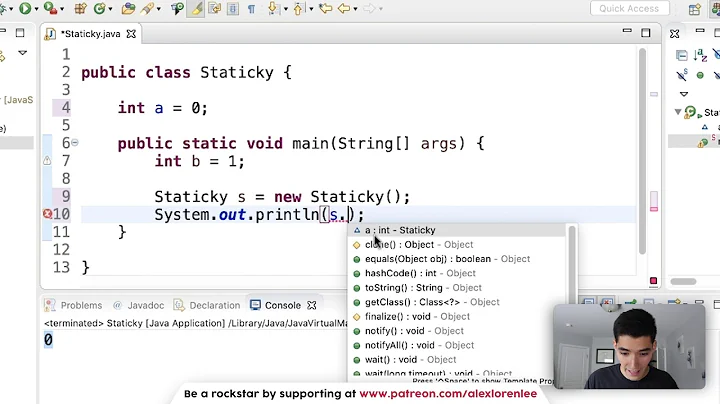How do synchronized static methods work in Java and can I use it for loading Hibernate entities?
Solution 1
By using synchronized on a static method lock you will synchronize the class methods and attributes ( as opposed to instance methods and attributes )
So your assumption is correct.
I am wondering if making the method synchronized is the right approach to ensure thread-safety.
Not really. You should let your RDBMS do that work instead. They are good at this kind of stuff.
The only thing you will get by synchronizing the access to the database is to make your application terribly slow. Further more, in the code you posted you're building a Session Factory each time, that way, your application will spend more time accessing the DB than performing the actual job.
Imagine the following scenario:
Client A and B attempt to insert different information into record X of table T.
With your approach the only thing you're getting is to make sure one is called after the other, when this would happen anyway in the DB, because the RDBMS will prevent them from inserting half information from A and half from B at the same time. The result will be the same but only 5 times ( or more ) slower.
Probably it could be better to take a look at the "Transactions and Concurrency" chapter in the Hibernate documentation. Most of the times the problems you're trying to solve, have been solved already and a much better way.
Solution 2
To address the question more generally...
Keep in mind that using synchronized on methods is really just shorthand (assume class is SomeClass):
synchronized static void foo() {
...
}
is the same as
static void foo() {
synchronized(SomeClass.class) {
...
}
}
and
synchronized void foo() {
...
}
is the same as
void foo() {
synchronized(this) {
...
}
}
You can use any object as the lock. If you want to lock subsets of static methods, you can
class SomeClass {
private static final Object LOCK_1 = new Object() {};
private static final Object LOCK_2 = new Object() {};
static void foo() {
synchronized(LOCK_1) {...}
}
static void fee() {
synchronized(LOCK_1) {...}
}
static void fie() {
synchronized(LOCK_2) {...}
}
static void fo() {
synchronized(LOCK_2) {...}
}
}
(for non-static methods, you would want to make the locks be non-static fields)
Solution 3
Static methods use the class as the object for locking, which is Utils.class for your example. So yes, it is OK.
Solution 4
static synchronized means holding lock on the the class's Class object
where as
synchronized means holding lock on that class's object itself. That means, if you are accessing a non-static synchronized method in a thread (of execution) you still can access a static synchronized method using another thread.
So, accessing two same kind of methods(either two static or two non-static methods) at any point of time by more than a thread is not possible.
Solution 5
Why do you want to enforce that only a single thread can access the DB at any one time?
It is the job of the database driver to implement any necessary locking, assuming a Connection is only used by one thread at a time!
Most likely, your database is perfectly capable of handling multiple, parallel access
Related videos on Youtube
tomato
Updated on January 11, 2021Comments
-
tomato over 3 years
If I have a util class with static methods that will call Hibernate functions to accomplish basic data access. I am wondering if making the method
synchronizedis the right approach to ensure thread-safety.I want this to prevent access of info to the same DB instance. However, I'm now sure if the following code are preventing
getObjectByIdbeing called for all Classes when it is called by a particular class.public class Utils { public static synchronized Object getObjectById (Class objclass, Long id) { // call hibernate class Session session = new Configuration().configure().buildSessionFactory().openSession(); Object obj = session.load(objclass, id); session.close(); return obj; } // other static methods } -
matt b about 15 yearsI am betting it is/was a workaround for some transactional issue. I.e., the solution doesn't solve the true problem
-
tomato about 15 yearsVery helpful answer!THANKS! So Hibernate takes care of cnocurrency by "optimistic locking". Then there is no need to use "synchronized" methods at all for resolve any data-access concurrecy?? Use "synchronized" methods only if the data are not stored in the database?? ..when DO you use them??
-
tomato about 15 yearsI didn't know that....I thought I'd have to manually implement this. Thanks for pointing it out! :)
-
tomato about 15 yearsI don't have any database background. Now I know!! Thanks for pointing it out! :)
-
OscarRyz about 15 years1) I think there are some means to use pessimistic locking too. 2) Nope, the RDBMS can do that work. 3) If the data is accessed by multiple threads at the same time. 4) synchronization is useful when two thread have to share data. If they don't need to, then much better!
-
OscarRyz about 15 yearsAny fast food restaurant uses multithread. One thread takes you order and use another thread to prepare it, and continues with the next customer. The synchronization point works only when they interchange information to know what to prepare. Following a model like that really simplifies life.
-
Martin Andersson about 11 years"the whole class" is not locked. The Java machine language specification:
For a class (static) method, the monitor associated with the Class object for the method's class is used. For an instance method, the monitor associated with this (the object for which the method was invoked) is used.Thus if one thread enters a static method, the same object returned by Object#getClass is locked. Other threads can still access instance methods. -
OscarRyz about 11 years@MartinAndersson That's correct, the whole class level artifacts (methods and attributes) are locked while the instance level artifacts are not. I'll update the wording
-
Martin Andersson about 11 yearslol I find that my own wording aren't that ultimately correct either. I said "Thus if one thread enters a static method, the same object returned by Object#getClass is locked". Not technically correct. Long story made short for all curious people: For each class in your application, there exist a
Classobject, instantiated by one of the virtual machines classloaders. Like all objects, this object too has aMonitorassociated with it. And this monitor is what is being locked. -
 Ryan Shillington almost 10 yearsThose top 4 code blocks are gold. Exactly what I was looking for. Thank you.
Ryan Shillington almost 10 yearsThose top 4 code blocks are gold. Exactly what I was looking for. Thank you. -
Samuel about 9 yearsIs it correct that if I use a static Lock on non-static method, no two objects of the class SomeClass will be able to run the block at the same time?
-
 Scott Stanchfield about 9 years@Samuel - Almost... It's more about threads than object instances. You're correct in that the separate instances of SomeClass will all use the same lock/monitor: the one associated with the Someclass.class object. So if two different threads were processing two different instances of SomeClass, they both couldn't run at the same time. However, if a single thread called a method in one instance of SomeClass, and that method called a method in the other instance, no blocking would happen.
Scott Stanchfield about 9 years@Samuel - Almost... It's more about threads than object instances. You're correct in that the separate instances of SomeClass will all use the same lock/monitor: the one associated with the Someclass.class object. So if two different threads were processing two different instances of SomeClass, they both couldn't run at the same time. However, if a single thread called a method in one instance of SomeClass, and that method called a method in the other instance, no blocking would happen. -
Bionix1441 about 7 years@ScottStanchfield You have listed ways for synchronizing methods, are they all equivalent ?
-
 Scott Stanchfield about 7 years@Bionix1441 - It's all about scoping. Each mechanism above gives you finer control of the locking. First, using the instance itself locking an entire method, then the instance itself to lock sections inside a method, then any object instance to lock sections.
Scott Stanchfield about 7 years@Bionix1441 - It's all about scoping. Each mechanism above gives you finer control of the locking. First, using the instance itself locking an entire method, then the instance itself to lock sections inside a method, then any object instance to lock sections.








